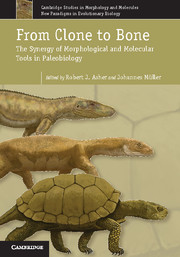Book contents
- Frontmatter
- Contents
- Contributors
- 1 Molecular tools in palaeobiology: divergence and mechanisms
- PART I Divergence
- 2 Genomics and the lost world: palaeontological insights into genome evolution
- 3 Rocking clocks and clocking rocks: a critical look at divergence time estimation in mammals
- 4 Morphological largess: can morphology offer more and be modelled as a stochastic evolutionary process?
- 5 Species selection in the molecular age
- PART II Mechanisms
- 6 Reconstructing the molecular underpinnings of morphological diversification: a case study of the Triassic fish Saurichthys
- 7 A molecular guide to regulation of morphological pattern in the vertebrate dentition and the evolution of dental development
- 8 Molecular biology of the mammalian dentary: insights into how complex skeletal elements can be shaped during development and evolution
- 9 Flexibility and constraint: patterning the axial skeleton in mammals
- 10 Molecular determinants of marsupial limb integration and constraint
- 11 A developmental basis for innovative evolution of the turtle shell
- 12 A molecular–morphological study of a peculiar limb morphology: the development and evolution of the mole's ‘thumb’
- 13 Manus horribilis: the chicken wing skeleton
- Index
- Plate-section
- References
12 - A molecular–morphological study of a peculiar limb morphology: the development and evolution of the mole's ‘thumb’
Published online by Cambridge University Press: 05 November 2012
- Frontmatter
- Contents
- Contributors
- 1 Molecular tools in palaeobiology: divergence and mechanisms
- PART I Divergence
- 2 Genomics and the lost world: palaeontological insights into genome evolution
- 3 Rocking clocks and clocking rocks: a critical look at divergence time estimation in mammals
- 4 Morphological largess: can morphology offer more and be modelled as a stochastic evolutionary process?
- 5 Species selection in the molecular age
- PART II Mechanisms
- 6 Reconstructing the molecular underpinnings of morphological diversification: a case study of the Triassic fish Saurichthys
- 7 A molecular guide to regulation of morphological pattern in the vertebrate dentition and the evolution of dental development
- 8 Molecular biology of the mammalian dentary: insights into how complex skeletal elements can be shaped during development and evolution
- 9 Flexibility and constraint: patterning the axial skeleton in mammals
- 10 Molecular determinants of marsupial limb integration and constraint
- 11 A developmental basis for innovative evolution of the turtle shell
- 12 A molecular–morphological study of a peculiar limb morphology: the development and evolution of the mole's ‘thumb’
- 13 Manus horribilis: the chicken wing skeleton
- Index
- Plate-section
- References
Summary
Introduction
Few areas of evolutionary investigation have benefited so much from the integration of molecular and morphological studies as that of the evolution of limbs (e.g. Shubin et al. 2009). Much effort has been concentrated on understanding the transition from ‘fins to limbs’ (Westoll 1943; Coates 1995; Shubin 1995; Shubin et al. 1997, 2004, 2006; Coates et al. 2002; Johanson et al. 2007; Larsson 2007) – for a recent summary of different aspects see Hall (2007) – but also major advances have been made concerning the origin and development of particularly specialized limbs such as those of bats (Sears et al. 2006; Sears 2008), whales (Thewissen et al. 2006), or their absence in snakes (Cohn and Tickle 1999). In fact, tetrapod limbs exhibit a stunning morphological diversity, reflecting their recruitment for a wide variety of functions ranging from walking to watch-making, often deployed as multipurpose structures serving in locomotion and support, personal hygiene, fighting, mating, manipulation and communication.
The reconstructed ground pattern of extant tetrapods may be viewed as a limb with a proximal stylopod (humeral/femoral region), a zeugopod (radial and ulnar/tibial and fibular region) and a distal, pentadactylous autopod (carpal/tarsal region), which contains the proximal mesopodium (wrist and ankle bones) and the terminal acropodium (the digits). With the notable exception of limbless tetrapods, most tetrapod limbs conservatively retain this pattern (Goodwin and Trainor 1983; Holder 1983). Based on these components, the diversity of skeletal morphology in tetrapod limbs is generated largely by differential growth and proportional changes of the common elements. Regarding the acropodia, hypodactyly, hyperphalangy and modifications of branching patterns involve various developmental mechanisms (Motani 1999; Hamrick 2001b, 2002; Richardson and Oelschläger 2002; Fedak and Hall 2004; Sears et al. 2007; Rolian 2008; Weisbecker and Nilsson 2008; Cooper and Dawson 2009).
- Type
- Chapter
- Information
- From Clone to BoneThe Synergy of Morphological and Molecular Tools in Palaeobiology, pp. 301 - 327Publisher: Cambridge University PressPrint publication year: 2012
References
- 3
- Cited by



